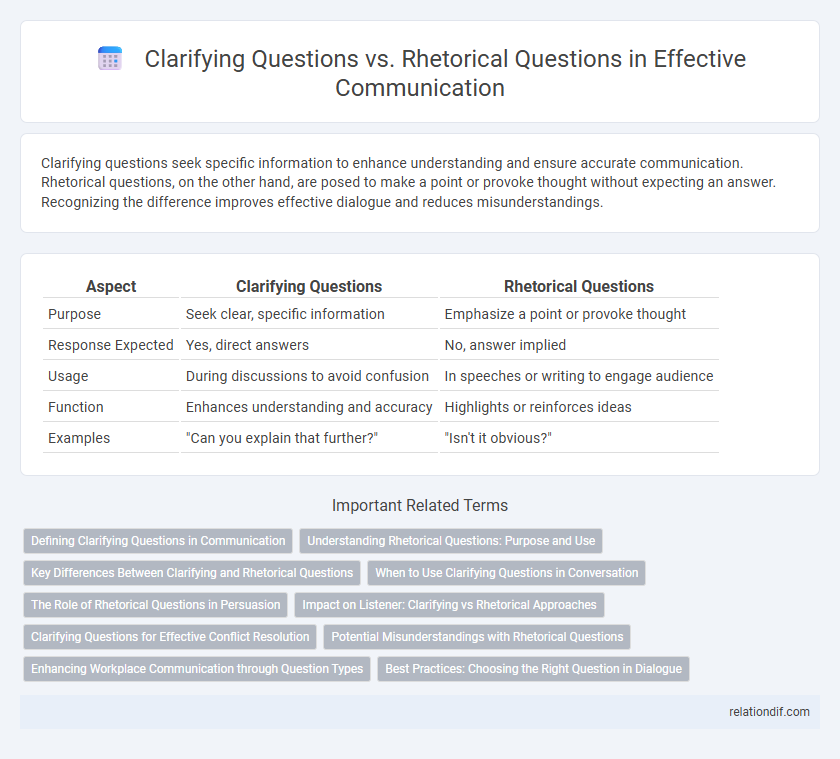Clarifying questions seek specific information to enhance understanding and ensure accurate communication. Rhetorical questions, on the other hand, are posed to make a point or provoke thought without expecting an answer. Recognizing the difference improves effective dialogue and reduces misunderstandings.
Table of Comparison
| Aspect | Clarifying Questions | Rhetorical Questions |
|---|---|---|
| Purpose | Seek clear, specific information | Emphasize a point or provoke thought |
| Response Expected | Yes, direct answers | No, answer implied |
| Usage | During discussions to avoid confusion | In speeches or writing to engage audience |
| Function | Enhances understanding and accuracy | Highlights or reinforces ideas |
| Examples | "Can you explain that further?" | "Isn't it obvious?" |
Defining Clarifying Questions in Communication
Clarifying questions in communication are inquiries aimed at gaining a clearer understanding of the speaker's message by requesting additional information or explanation. They help reduce misunderstandings and ensure accurate interpretation of the information conveyed. Unlike rhetorical questions, clarifying questions seek explicit answers to enhance effective dialogue.
Understanding Rhetorical Questions: Purpose and Use
Rhetorical questions are used in communication to engage the audience and provoke thought without expecting an actual response, serving as a persuasive or stylistic device. Unlike clarifying questions that seek specific information to enhance understanding, rhetorical questions emphasize a point or highlight an idea implicitly. Effective use of rhetorical questions can strengthen arguments and make messages more memorable by encouraging internal reflection.
Key Differences Between Clarifying and Rhetorical Questions
Clarifying questions seek specific information to resolve confusion and enhance understanding, often beginning with words like "what," "how," or "why." Rhetorical questions, however, are posed for effect or persuasion without expecting an actual answer, serving to emphasize a point or provoke thought. Key differences include their intent--clarifying questions aim to gather information, while rhetorical questions aim to engage or influence the audience.
When to Use Clarifying Questions in Conversation
Clarifying questions are essential in conversations to ensure understanding, especially when information is complex or ambiguous. Use clarifying questions to confirm details, prevent misunderstandings, and promote active listening by encouraging speakers to elaborate. Employing these questions enhances communication effectiveness by fostering clarity and mutual comprehension.
The Role of Rhetorical Questions in Persuasion
Rhetorical questions play a crucial role in persuasion by engaging the audience and prompting them to reflect on the implied message without expecting a direct answer. These questions create emphasis and encourage agreement by highlighting key points or challenging assumptions, making the argument more compelling. Unlike clarifying questions, rhetorical questions are designed to influence thought and emotion, thereby enhancing the speaker's persuasive impact.
Impact on Listener: Clarifying vs Rhetorical Approaches
Clarifying questions directly engage the listener by seeking specific information, enhancing understanding and encouraging active participation in the conversation. Rhetorical questions, on the other hand, are designed to provoke thought or emphasize a point without expecting an answer, often influencing the listener's perspective subtly. The impact on the listener varies as clarifying questions promote clarity and dialogue, whereas rhetorical questions drive reflection and emotional response.
Clarifying Questions for Effective Conflict Resolution
Clarifying questions play a crucial role in effective conflict resolution by ensuring all parties fully understand each other's perspectives and concerns. These questions promote active listening and reduce misunderstandings, enabling clearer communication and facilitating mutually beneficial solutions. Unlike rhetorical questions, clarifying questions encourage open dialogue and help uncover the root causes of conflicts.
Potential Misunderstandings with Rhetorical Questions
Rhetorical questions often cause potential misunderstandings because they imply an answer rather than seek one, leading listeners to misinterpret the speaker's intent. Unlike clarifying questions designed to elicit information or confirm understanding, rhetorical questions can create confusion if the audience takes them literally. Effective communication requires recognizing when rhetorical questions might obscure meaning or hinder clear dialogue.
Enhancing Workplace Communication through Question Types
Clarifying questions in workplace communication facilitate understanding by seeking specific information, reducing ambiguity, and promoting effective collaboration. Rhetorical questions, while not seeking direct answers, engage listeners, provoke critical thinking, and emphasize key points in discussions or presentations. Utilizing both question types strategically enhances message clarity and fosters a dynamic communication environment.
Best Practices: Choosing the Right Question in Dialogue
Clarifying questions are essential for acquiring precise information and ensuring mutual understanding, often starting with who, what, where, when, why, or how. Rhetorical questions, designed to provoke thought or emphasize a point without expecting an answer, enhance engagement and persuasion in dialogue. Effective communication relies on selecting clarifying questions to resolve ambiguities and rhetorical questions to underscore key messages strategically.
clarifying questions vs rhetorical questions Infographic

 relationdif.com
relationdif.com